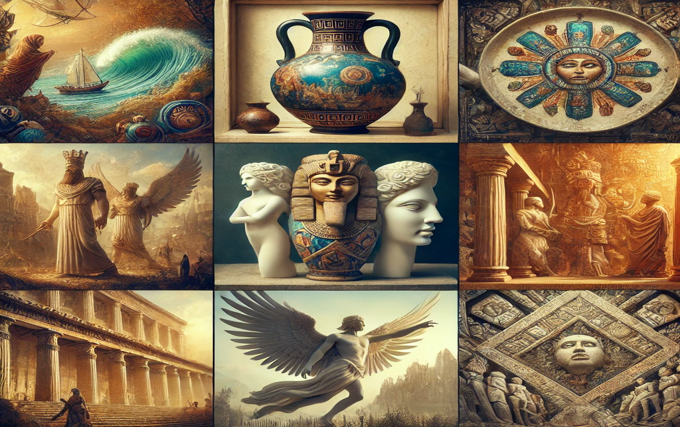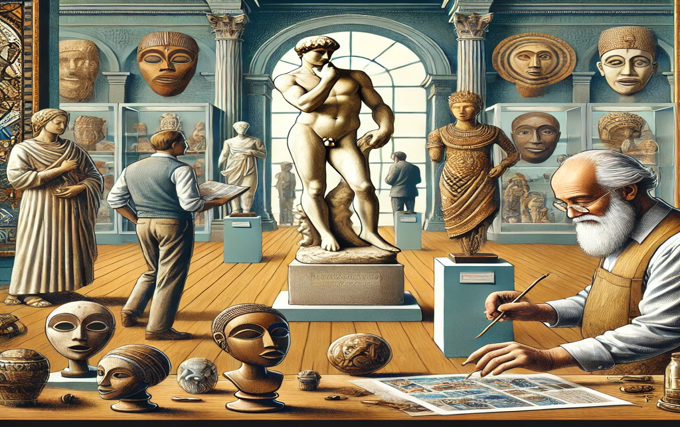Art is more than just a form of expression. It holds the key to understanding ancient civilizations and their contributions to the world. “Ancient Artz” refers to the art forms created by early societies, from cave paintings to intricate sculptures. These works reveal the thoughts, beliefs, and daily lives of people who lived thousands of years ago. This article explores how ancient art has shaped our modern culture, its lasting influence on our aesthetics, and how it continues to inspire today’s artists.
The Roots of Ancient Art
The First Expressions of Human Creativity
Art began with the simplest of tools. The earliest forms of art, such as cave paintings found in places like Lascaux, France, show humans using pigments from nature to depict animals and hunting scenes. These early artists weren’t just drawing; they were telling stories, recording events, and leaving their mark on history.
- Cave Art: One of the earliest forms of artistic expression, depicting hunting and nature scenes.
- Petroglyphs: Carved rock art that captured symbols and messages of early humans.
Ancient Art Across Civilizations
Every ancient civilization had its unique style and purpose for creating art. The Egyptians, known for their monumental sculptures and detailed hieroglyphs, used art to honor their gods and pharaohs. Meanwhile, Greek and Roman artists were more focused on realism, with detailed sculptures representing mythological figures and daily life.
- Egyptian Art: Recognized for its symbolic forms and connection to spirituality.
- Greek and Roman Art: Emphasized realism and human beauty, impacting Western culture significantly.
Art as a Reflection of Society
Storytelling Through Art
Ancient artists played the role of historians, documenting stories and significant events. For example, the Greeks used pottery to depict scenes from mythology, while the Mayans carved intricate stories into stone monuments. These works not only served aesthetic purposes but also passed down cultural narratives from one generation to the next.
- Pottery and Vase Painting: Utilized to portray myths, legends, and daily life in ancient Greece.
- Monumental Sculptures: Often told stories of rulers, battles, and conquests, as seen in Mayan art.
Art’s Role in Religion and Power
Art was also a powerful tool in religion and governance. Temples, shrines, and religious statues were designed not just for decoration but to convey the power and presence of the divine. In many cultures, art reinforced the authority of rulers by depicting them as divine beings or larger-than-life figures.
- Religious Sculptures: Used to communicate with the gods and represent spiritual beliefs.
- Monarchic Portraits: Kings and pharaohs were often depicted as godlike figures to reinforce their rule.

The Influence of Ancient Art on Modern Culture
Architectural Inspiration
Modern architecture owes much to ancient civilizations. Greek columns, Roman arches, and Egyptian pyramids all left lasting impressions on how we design buildings today. The use of symmetry, proportion, and grand scale continues to influence architects worldwide.
- Greek Columns: Ionic, Doric, and Corinthian columns can still be seen in modern government buildings and monuments.
- Roman Arches: Inspired modern bridges, aqueducts, and stadiums with their innovative use of curved structures.
The Evolution of Artistic Techniques
Many techniques used by ancient art have survived the centuries and are still practiced today. Fresco painting, mosaic making, and sculpture carving are just a few examples. Renaissance artists revived many ancient techniques, blending them with newer ideas to create a fusion that has defined Western art.
- Frescoes: A wall-painting technique developed by ancient civilizations and later revived during the Renaissance.
- Mosaics: Composed of small pieces of colored stone, glass, or ceramics, used in both ancient and contemporary art.
The Lasting Legacy of Ancient Art
Inspiration for Modern Artists
Artists throughout history have drawn inspiration from ancient works. From the Renaissance to modern abstract art, the timeless beauty and depth of ancient creations continue to captivate. Artists like Picasso and Matisse often looked to African masks and ancient sculptures for inspiration.
- Renaissance Revival: Artists like Michelangelo studied ancient sculptures to perfect their craft.
- Modern Artists: Many modern painters and sculptors reference ancient styles in their works.
Preservation of Ancient Art
The preservation of ancient artz remains a significant cultural responsibility. Museums and archaeologists work tirelessly to ensure that these works are not lost to time. By studying these pieces, we gain a better understanding of human history, creativity, and evolution.
- Museums and Conservation: Institutions like the Louvre and the British Museum house and preserve ancient art.
- Archaeological Discoveries: Ongoing excavations continue to reveal hidden treasures from ancient cultures.

Conclusion
“Ancient Artz” serves as a bridge between the past and present, providing insight into human history and creativity. From the earliest cave paintings to the grand monuments of ancient empires, these works have left an indelible mark on our culture. They continue to inspire modern artists and shape our understanding of the world. As we preserve and study these ancient masterpieces, we keep alive the stories and legacies of those who came before us.


